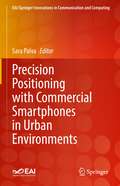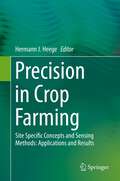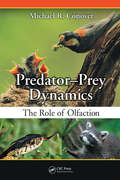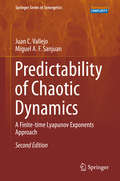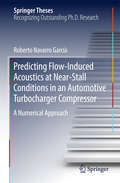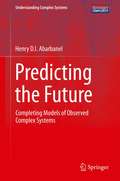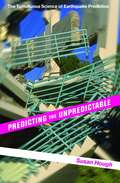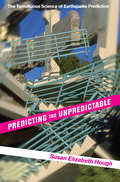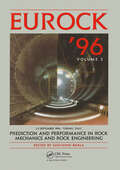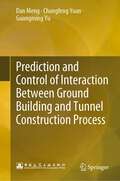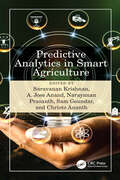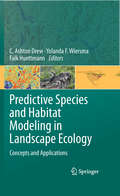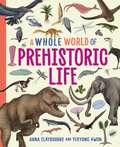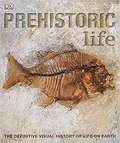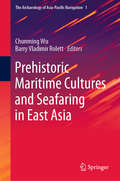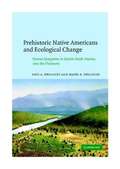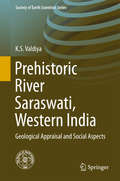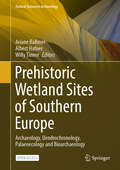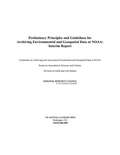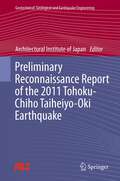- Table View
- List View
Precision Positioning with Commercial Smartphones in Urban Environments (EAI/Springer Innovations in Communication and Computing)
by Sara PaivaThis book discusses recent technologies and case studies that aim to enhance positioning obtained with commercial smartphones in urban environments, overcoming difficulties with GPS. The authors provide insight into recent trends and innovation on technologies, solutions and approaches to overcome GPS issues in urban environments, due to the existence of a big number of buildings. Topics include security and legal aspects related to positioning systems, the usage of crowdsourcing approaches to enhance positioning, location-based services, proximity based-social networking, satellite navigation and Bluetooth low-energy based systems. The book provides important information for developers that intend to make use of precise positioning for the purpose of commercial applications as well as for research and innovation.Discusses technologies that enhance positioning obtained with commercial smartphones in urban environments;Presents innovations to overcome GPS issues in urban environments caused by dense cities;Includes applications of precise positioning, including their security issues and challenges.
Precision in Crop Farming: Applications and Results
by Hermann HeegeHigh yields and environmental control in crop farming call for precise adaptations to local growing conditions. Treating large fields in a uniform way by high capacity machinery cannot be regarded as a sustainable method for many situations. Because differences existing within single fields must be considered. The transition from former field work carried out manually or by small implements to present-day high-capacity machinery caused that the farmers lost the immediate and close contact with soils and crops. However, modern sensing and controlling technology can make up for this deficit. High tech methods that include proximal sensing and signals from satellites can provide for controls that allow adjusting farming operations to small fractions of one ha and sometimes even down to some m2, hence in a site-specific mode. This applies to operations for soil cultivation, sowing, fertilizing and plant protection. This book deals with site-specific concepts, applications and results.
Predator-Prey Dynamics: The Role of Olfaction
by Michael R. ConoverHumans, being visually oriented, are well versed in camouflage and how animals hide from predators that use vision to locate prey. However, many predators do not hunt by sight; they hunt by scent. This raises the question: do survival mechanisms and behaviors exist which allow animals to hide from these olfactory predators? If so, what are they, a
Predictability of Chaotic Dynamics: A Finite-time Lyapunov Exponents Approach (Springer Series in Synergetics)
by Juan C. Vallejo Miguel A. SanjuanThis book is primarily concerned with the computational aspects of predictability of dynamical systems - in particular those where observations, modeling and computation are strongly interdependent. Unlike with physical systems under control in laboratories, in astronomy it is uncommon to have the possibility of altering the key parameters of the studied objects. Therefore, the numerical simulations offer an essential tool for analysing these systems, and their reliability is of ever-increasing interest and importance. In this interdisciplinary scenario, the underlying physics provide the simulated models, nonlinear dynamics provides their chaoticity and instability properties, and the computer sciences provide the actual numerical implementation. This book introduces and explores precisely this link between the models and their predictability characterization based on concepts derived from the field of nonlinear dynamics, with a focus on the strong sensitivity to initial conditions and the use of Lyapunov exponents to characterize this sensitivity. This method is illustrated using several well-known continuous dynamical systems, such as the Contopoulos, Hénon-Heiles and Rössler systems. This second edition revises and significantly enlarges the material of the first edition by providing new entry points for discussing new predictability issues on a variety of areas such as machine decision-making, partial differential equations or the analysis of attractors and basins. Finally, the parts of the book devoted to the application of these ideas to astronomy have been greatly enlarged, by first presenting some basics aspects of predictability in astronomy and then by expanding these ideas to a detailed analysis of a galactic potential.
Predicting Flow-Induced Acoustics at Near-Stall Conditions in an Automotive Turbocharger Compressor
by Roberto Navarro GarcíaThis thesis offers new insights into the fluid flow behavior of automotive centrifugal compressors operating under near-stall conditions. Firstly it discusses the validation of three-dimensional computational fluid dynamics (CFD) unsteady simulations against acoustic experimental measurements using an original procedure based on plane wave pressure decomposition. It then examines the configuration of the CFD cases, highlighting the key parameters needed for a successful calculation. Moreover, it describes both the compressor mean and unsteady flow field from best-efficiency to near-surge operating points. Lastly, it provides readers with explanations of the various phenomena that arise when the mass flow rate is reduced and the compressor is driven to poor and noisy performance. Written for students, researchers and professionals who want to improve their understanding of the complex fluid flow behavior in centrifugal compressors, the thesis offers valuable practical insights into reducing the acoustic emissions of turbochargers.
Predicting Outcomes of Investments in Maintenance and Repair of Federal Facilities
by Committee on Predicting Outcomes of Investments in Maintenance Repair for Federal Facilities"Challenging. . . The real value of this book is in Mr. Hacker's calm, analytical eye, his unblinking view of American history and his unwillingness to accept cant and 'common sense' as facts. " --Tom Wicker The New York Times Book Review Why does race remain America's deepest and most enduring division? Despite all efforts to increase understanding and expand opportunities, black and white Americans still lead separate lives, continually marked by tension and hostility. In his bestselling analysis of a divided society, Andrew Hacker explains why racial disparities persist. He clarifies the meaning of racism, conflicting theories of superiority and equality, as well as such subtle factors as guilt and sexual fears. Using completely updated statistical data to paint the stark picture of racial inequality, Two Nations depicts the realities of family life, of income and employment, as well as current controversies affecting education, politics, and crime, including the role of race in the Simpson trial. This startling look at the facts that so many choose to ignore is balanced by the voices of African Americans, and shows how race influences the attitudes and behavior of all Americans. Reasoned, accurate, and devastating, Two Nations demonstrates, better than emotional appeals can, how this great and dividing issue has defined America's history and, as Hacker forecasts it, will play a pivotal role in the coming century. "Provocatively enlightening. . . Probably the most candid book on present day American racism to be written in the 20th century. " --Claude Brown Author of Manchild in the Promised Land "A telling portrait of American life. . . of the very different ways the two races live. . . The numbers are stark and irrefutable. " --The Wall Street Journal EXPANDED AND UPDATED EDITION -- Including a new chapter on the O. J. trial
Predicting the Future
by Henry AbarbanelThrough the development of an exact path integral for use in transferring information from observations to a model of the observed system, the author provides a general framework for the discussion of model building and evaluation across disciplines. Through many illustrative examples drawn from models in neuroscience, geosciences, and nonlinear electrical circuits, the concepts are exemplified in detail. Practical numerical methods for approximate evaluations of the path integral are explored, and their use in designing experiments and determining a model's consistency with observations is explored.
Predicting the Unpredictable
by Susan HoughAn earthquake can strike without warning and wreak horrific destruction and death, whether it's the cataclysmic 2008 Sichuan quake in China that killed tens of thousands or a future great earthquake on the San Andreas Fault in California, which scientists know is inevitable. Yet despite rapid advances in earthquake science, seismologists still can't predict when the Big One will hit. Predicting the Unpredictable is the first book to explain why, exploring the fact and fiction behind the science--and pseudoscience--of earthquake prediction. Susan Hough traces the continuing quest by seismologists to forecast the time, location, and magnitude of future quakes--a quest fraught with controversies, spectacular failures, and occasional apparent successes. She brings readers into the laboratory and out into the field with the pioneers who have sought to develop reliable methods based on observable phenomena such as small earthquake patterns and electromagnetic signals. Hough describes attempts that have raised hopes only to collapse under scrutiny, as well as approaches that seem to hold future promise. She recounts stories of strange occurrences preceding massive quakes, such as changes in well water levels and mysterious ground fogs. She also ventures to the fringes of pseudoscience to consider ideas outside the scientific mainstream, from the enduring belief that animals can sense impending earthquakes to amateur YouTube videos purporting to show earthquake lights prior to large quakes. This book is an entertaining and accessible foray into the world of earthquake prediction, one that illuminates the unique challenges of predicting the unpredictable.
Predicting the Unpredictable: The Tumultuous Science of Earthquake Prediction
by Susan Elizabeth HoughAn earthquake can strike without warning and wreak horrific destruction and death, whether it's the catastrophic 2010 quake that took a devastating toll on the island nation of Haiti or a future great earthquake on the San Andreas Fault in California, which scientists know is inevitable. Yet despite rapid advances in earthquake science, seismologists still can't predict when the Big One will hit. Predicting the Unpredictable explains why, exploring the fact and fiction behind the science--and pseudoscience--of earthquake prediction. Susan Hough traces the continuing quest by seismologists to forecast the time, location, and magnitude of future quakes. She brings readers into the laboratory and out into the field--describing attempts that have raised hopes only to collapse under scrutiny, as well as approaches that seem to hold future promise. She also ventures to the fringes of pseudoscience to consider ideas outside the scientific mainstream. An entertaining and accessible foray into the world of earthquake prediction, Predicting the Unpredictable illuminates the unique challenges of predicting earthquakes.
Prediction And Performance In Rock Mechanics and Rock Engineering
by Giovanni BarlaA collection of conference proceedings on rock mechanics and rock engineering covering such topics as: foundations of dams, bridges and large structures; mining structures; formulation of geotechnical models; rock mass characterization; and recent advances in modelling.
Prediction and Control of Interaction Between Ground Building and Tunnel Construction Process
by Dan Meng Changfeng Yuan Guangming YuThis book covers tunnel construction and building construction and design. It has two parts. Part one is for the engineering practice of the subway tunnel through the base of the building in typical geological conditions, to study the mechanism and law of building damage caused by stratum deformation by in-situ monitoring, numerical simulation and theoretical analysis methods. At the same time, the risk management of subway tunnel through the bottom of the building is discussed. Second part, in view of the excavation and unloading of the foundation pit and the main structure loading in the process of high-rise building construction, discusses optimization of the construction scheme, systematic evaluation of the safety of the existing tunnel and control measures combined with the engineering practice. This book provides a valuable contribution to the field of tunnel construction and design and construction of building for both the engineering experts and graduate students as well.
Predictive Analytics in Smart Agriculture
by Saravanan Krishnan Sam Goundar Narayanan Prasanth Christo Ananth A. Jose AnandPredictive Analysis in Smart Agricultureexplores computational engineering techniques and applications in agriculture development. Recent technologies such as cloud computing, IoT, big data, and machine learning are focused on for smart agricultural engineering. The book also provides a case-oriented approach for IoT-based agricultural systems.This book deals with all aspects of smart agriculture with state-of-the-art predictive analysis in the complete 360-degree view spectrum. The book includes the concepts of urban and vertical farming using Agro IoT systems and renewable energy sources for modern agriculture trends. It discusses the real-world challenges, complexities in Agro IoT, and advantages of incorporating smart technology. It also presents the rapid advancement of the technologies in the existing Agri model by applying the various techniques. Novel architectural solutions in smart agricultural engineering are the core aspects of this book. Several predictive analysis tools and smart agriculture are also incorporated.This book can be used as a textbook for students in predictive analysis, agriculture engineering, precision farming, and smart agriculture. It can also be a reference book for practicing professionals in cloud computing, IoT, big data, machine learning, and deep learning working on smart agriculture applications.
Predictive Species and Habitat Modeling in Landscape Ecology
by Falk Huettmann Yolanda F. Wiersma C. Ashton DrewMost projects in Landscape Ecology, at some point, define a species-habitat association. These models are inherently spatial, dealing with landscapes and their configurations. Whether coding behavioral rules for dispersal of simulated organisms through simulated landscapes, or designing the sampling extent of field surveys and experiments in real landscapes, landscape ecologists must make assumptions about how organisms experience and utilize the landscape. These convenient working postulates allow modelers to project the model in time and space, yet rarely are they explicitly considered. The early years of landscape ecology necessarily focused on the evolution of effective data sources, metrics, and statistical approaches that could truly capture the spatial and temporal patterns and processes of interest. Now that these tools are well established, we reflect on the ecological theories that underpin the assumptions commonly made during species distribution modeling and mapping. This is crucial for applying models to questions of global sustainability. Due to the inherent use of GIS for much of this kind of research, and as several authors' research involves the production of multicolored map figures, there would be an 8-page color insert. Additional color figures could be made available through a digital archive, or by cost contributions of the chapter authors. Where applicable, would be relevant chapters' GIS data and model code available through a digital archive. The practice of data and code sharing is becoming standard in GIS studies, is an inherent method of this book, and will serve to add additional research value to the book for both academic and practitioner audiences.
Prehistoric Life (A Whole World of... #1)
by Anna ClaybourneGet lost in the diverse and bustling world of prehistoric life - with more to explore than you ever imagined!A Whole World of Prehistoric Life presents the stunning breadth of animal and plant varieties that filled prehistoric Earth. Which types of animal could swim or fly? When did flowers start appearing? Where do the dinosaurs fit into all of it? Which living things look familiar, and which look absolutely alien? This book has the answers and so many more facts filling the beautifully illustrated pages.A Whole World of is a book series looking at the extraordinary diversity of life on Earth - the defining features and evolutionary branches - and encourages readers age 7 and up to consider why it is important to maintain biodiversity. Written by award-winning author, Anna Claybourne, with artwork by award-winning illustrator, Yekyung Kwon.Books in the series:A Whole World of Mammals/A Whole World of Prehistoric Life/A Whole World of Minibeasts/A Whole World of Birds/A Whole World of Rocks and Minerals/A Whole World of Plants and Fungi
Prehistoric Life: The Definitive Visual History of Life on Earth
by Dorling Kindersley Publishing StaffWith an extensive catalog at its heart, Prehistoric Life profiles hundreds of fascinating species in incredible detail. The story starts in earnest 3.8 billion years ago, with the earliest-known form of life on Earth, a bacteria that still exists today, and journeys through action-packed millennia, charting the appearance of new life forms as well as devastating extinction events. Of course, the ever-popular and endlessly intriguing dinosaurs feature large, but Prehistoric Life gives you the whole picture, and the plants, invertebrates, amphibians, birds, reptiles, and mammals that are the ancestors of today's species also populate its pages, making this book unprecedented in its coverage of prehistory. <P><P>Specially commissioned artworks use cutting-edge technology to render species in breathtakingly realistic fashion, with astonishing images of prehistoric remains, such as skeletons and fossils, to complete the story. To put all the evidence in context, the concept of geological time is explored, as is the classification of species and how the evidence for their evolution is preserved and can be deciphered.
Prehistoric Maritime Cultures and Seafaring in East Asia (The Archaeology of Asia-Pacific Navigation #1)
by Chunming Wu Barry Vladimir RolettThis book focuses on prehistoric East Asian maritime cultures that pre-dated the Maritime Silk Road, the "Four Seas" and "Four Oceans" navigation system recorded in historical documents of ancient China. Origins of the Maritime Silk Road can be traced to prosperous Neolithic and Metal Age maritime-oriented cultures dispersed along the coastlines of prehistoric China and Southeast Asia.The topics explored here include Neolithisation and the development of prehistoric maritime cultures during the Neolithic and early Metal Age; the expansion and interaction of these cultures along coastlines and across straits; the "two-layer" hypothesis for explaining genetic and cultural diversity in south China and Southeast Asia; prehistoric seafaring and early sea routes; the paleogeography and vegetation history of coastal regions; Neolithic maritime livelihoods based on hunting/fishing/foraging adaptations; rice and millet cultivation and their dispersal along the coast and across the open sea; and interaction between farmers and maritime-oriented hunter/fisher/foragers. In addition, a series of case studies enhances understanding of the development of prehistoric navigation and the origin of the Maritime Silk Road in the Asia-Pacific region.
Prehistoric Native Americans And Ecological Change: Human Ecosystems In Eastern North America Since The Pleistocene
by Paul A. Delcourt Hazel R. DelcourtThere has long been controversy between ecologists and archaeologists over the role of prehistoric Native Americans as agents of ecological change. Using ecological and archaeological data from the woodlands of eastern North America, Paul and Hazel Delcourt show that Holocene human ecosystems are complex adaptive systems in which humans have interacted with the environment on a series of spatial and time scales. Their work therefore has important implications for the conservation of biological diversity and for ecological restoration today, making it of great interest to ecologists and archaeologists alike.
Prehistoric River Saraswati, Western India
by K. S. ValdiyaThis book portrays the Himalayan-born River Saraswati, a legendary river that was the lifeline of a progressive and vibrant society for more than three thousand years. Written in simple language and richly illustrated, it highlights the events that resulted in the robbing of the Saraswati of its water and the end of a wonderful culture. The author weaves a geological narrative out of a mass of data generated by explorers, archaeologists, sedimentologists, geohydrologist, seismologists and remote-sensing specialists. The story explains how a great Himalayan river disappeared and how the Harappan Civilization vanished from the banks of the river Saraswati more than three and half thousand years ago in the wake of tectonic upheavals in the foothills of the Himalaya at a time when the rainfall had drastically declined. And it reveals that nowadays the Saraswati is an extraordinary wide water-less channel coursing through the vast but dry floodplain in western India.
Prehistoric Wetland Sites of Southern Europe: Archaeology, Dendrochronology, Palaeoecology and Bioarchaeology (Natural Science in Archaeology)
by Ariane Ballmer Albert Hafner Willy TinnerThis is an open access book. Unique in its scope, this book provides for the first time a Southern European perspective on prehistoric wetland settlements and their natural environment. These are dwellings originally built in humid locations, i.e. on shores and in shallow water areas of lakes, bogs, marshes, rivers, estuaries and lagoons. The relevant archaeological remains are in most cases waterlogged and offer outstanding preservation conditions for organic materials and are moreover in close proximity to uninterrupted natural archives (e.g. lake or mire sediments), which allows for a broad range of transdisciplinary research approaches. The sites discussed in this book date from the Neolithic and the Bronze Age (c. 5500–1000 BC), and are located in nine countries of Southern Europe, i.e. Spain, France, Italy, Slovenia, Croatia, North Macedonia, Albania, Greece and Bulgaria. Four dimensions of prehistoric wetland settlements are explored in the book – the archaeological, the dendroarchaeological, the palaeoecological and the bioarchaeological: Part I is dedicated to archaeology, i.e. the excavation of settlement remains, their transdisciplinary exploration as well as their interpretation; Part II deals with dendroarchaeology and its contribution to the understanding of occupation sequences and regional chronologies; and Part III concerns uninterrupted off-site palaeoecological records of past ecosystem change, including human–environment interactions, as well as bioarchaeological on-site approaches to subsistence strategies and land use practices. Prehistoric Wetland sites of Southern Europe showcases how different disciplines and areas of expertise from the humanities and the natural sciences meet on an equal footing to elaborate coherent pictures of the past. Besides a cross-section of research statuses of different archaeological sites, currently ongoing research as well as novel, hitherto unpublished case studies and findings are made accessible to the international research community. Drawing on a wide range of expert contributions from both archaeology and the natural sciences, this book targets scholars, professionals, and students from the fields of prehistoric archaeology and palaeo-sciences, and is furthermore of interest to cultural-heritage stakeholders.
Preliminary Principles and Guidelines for Archiving Environmental and Geospatial Data at NOAA: Interim Report
by National Research Council of the National AcademiesThe National Oceanic and Atmospheric Administration (NOAA) collects and manages a wide range of environmental and geospatial data to fulfill its mission requirements--data that stretch from the surface of the sun to the core of the earth, and affect every aspect of society. With limited resources and enormous growth in data volumes, NOAA asked the National Academies for advice on how to archive and provide access to these data. This book offers preliminary principles and guidelines that NOAA and its partners can use to begin planning specific archiving strategies for the data streams they currently collect. For example, the book concludes that the decision to archive environmental or geospatial data should be driven by its current or future value to society, and that funding for environmental and geospatial measurements should include sufficient resources to archive and provide access to the data these efforts generate. The preliminary principles and guidelines proposed in this book will be refined and expanded to cover data access issues in a final book expected to be released in 2007.
Preliminary Reconnaissance Report of the 2011 Tohoku-Chiho Taiheiyo-Oki Earthquake
by Architectural Institute of JapanDevastating damage in the Tohoku region of Japan occurred during and after the earthquake off the Pacific coast of Tohoku earthquake on March 11, 2011. The AIJ (Architectural Institute of Japan) dispatched reconnaissance teams into the field to obtain basic facts on the damage to buildings due to the massive ground motions and resultant tsunami. Their mission included collecting information on the characteristics of the earthquake itself and the observed major ground motions and tsunamis throughout the area. For the structural damage investigation, buildings are classified by their type of construction, namely, steel buildings, reinforced concrete buildings, wooden houses, etc. along with descriptions of special features for each category of building type. The report summarizes damage associated with ground failures including landslide and liquefaction as well as non-structural damages such as to equipment and facilities, partitioning walls and ceilings, and functional failures in skyscrapers. Also brief description of the Japanese Seismic Design Code will be provided in the Appendix. A proposed scheme of anti-tsunami design for buildings is also included.
Prentice Hall Brief Review Earth Science: The Physical Setting
by Jeffrey C. CallisterThis book is designed to enhance review of the concepts, skills, and application of the Physical Setting/Earth Science Core Curriculum that may be tested on the Regents Examination for The Physical Setting: Earth Science. Students can use the book in any order as each topic is independent except for the introduction of vocabulary words.
Prentice Hall Earth Science
by Edward J. Tarbuck Frederick K. Lutgens Dennis TasaNIMAC-sourced textbook
Prentice Hall Earth Science
by Edward J. Tarbuck Frederick K. Lutgens Dennis TasaNIMAC-sourced textbook
Prentice Hall Earth Science
by Edward J. Tarbuck Frederick K. Lutgens Dennis TasaNIMAC-sourced textbook
